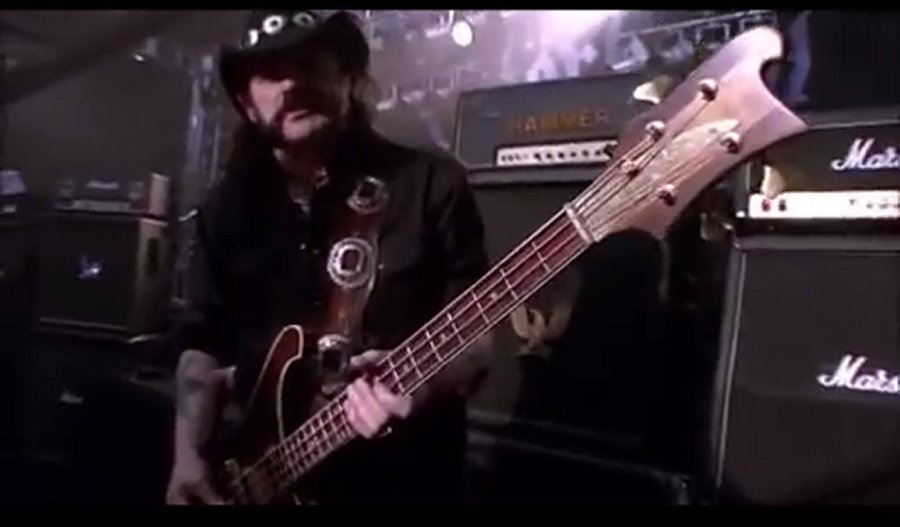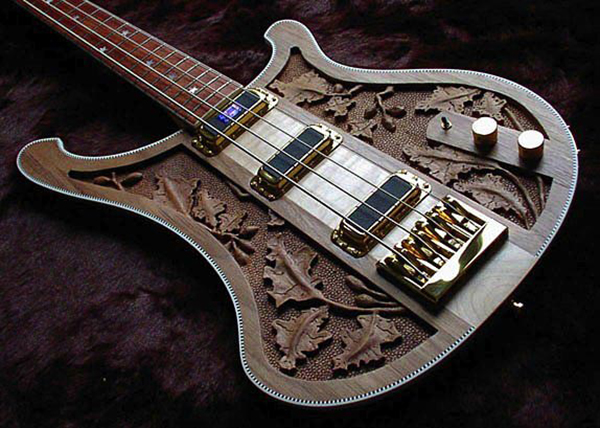Lemmy Kilmister famously played a Rickenbacker 4001 bass guitar. This distinctive instrument became his trademark throughout his career with Motörhead.
Lemmy’s unique sound resonated through the strings of his Rickenbacker, which he often customized with various modifications to suit his aggressive playing style. Known for their punchy midrange and treble, Rickenbacker basses helped Lemmy craft the relentless driving bass lines that became a staple of Motörhead’s heavy metal sound.
Despite the wear and tear of relentless touring and recording sessions, Lemmy’s Rickenbacker proved to be as resilient as his legendary persona. Aspiring bassists and fans continue to associate the iconic shape and booming sound of the Rickenbacker 4001 with the late, great Lemmy Kilmister.

Credit: www.bestbassgear.com
The Iconic Bass Guitar Of Lemmy Kilmister
Lemmy Kilmister, frontman of Motörhead and rock ‘n’ roll legend, was known not just for his raspy voice but also for the unmistakable sound of his bass guitar. The instrument became a symbol of Lemmy’s raw energy and musical prowess, cementing his place in rock history.
Introduction To Lemmy’s Legacy In Music
Ian Fraser “Lemmy” Kilmister was a force to be reckoned with in the music industry. With a career spanning over four decades, Lemmy became the embodiment of heavy metal and hard rock. His aggressive playing style and unique approach to the bass guitar contributed significantly to Motörhead’s signature sound. Fans and musicians alike revered Lemmy for his authenticity and unapologetic dedication to the music he loved.
Overview Of Lemmy’s Choice In Bass Guitars
Lemmy’s bass of choice was the Rickenbacker 4001/4003. This particular model, known for its growling overdriven tones, was used by Lemmy to create a blend of rhythm and lead which became his trademark sound. Notably, Lemmy customized his Rickenbacker to suit his aggressive playing style, often modifying the hardware and pickups to achieve the perfect growl that Motörhead’s music demanded.
- Manufacturer: Rickenbacker
- Models: 4001 / 4003
- Custom Modifications:
- High-output pickups
- Removed frets (occasionally)
- Unique wiring configurations
- Bass often featured a notable custom mirrored pickguard
Lemmy’s use of the Rickenbacker bass was not without reason; it allowed him to achieve a sound that was both powerful and distinctive. With it, he propelled Motörhead’s songs with driving basslines that were pivotal to the band’s hard-hitting sound. Lemmy’s customized Rickenbacker was more than an instrument—it was an extension of his musical vision and a piece of rock ‘n’ roll history.
Lemmy’s Mainstay: Rickenbacker 4001/4003
For fans of classic rock and heavy metal, the image of Lemmy Kilmister, the frontman of Motörhead, and his iconic bass guitar is legendary. Lemmy’s primary weapon of choice on stage and in the studio was none other than the Rickenbacker 4001/4003. This bass, with its distinguished design and powerful tone, wasn’t just an instrument for Lemmy; it was an extension of his raw, unapologetic musical persona. Let’s dive into what made this particular model a rock ‘n’ roll mainstay for one of the genre’s most revered figures.
The Features That Made Rickenbacker Lemmy’s Favorite
The Rickenbacker 4001 and 4003 bass guitars pack a punch with features that perfectly complemented Lemmy’s playing style:
- Solid maple body contributing to a sustain that can power through any mix.
- A unique ‘cresting wave’ body design that stood out visually on any stage.
- Neck-through-body construction providing amazing resonance and stability.
- Dual truss rods for extra neck durability, allowing Lemmy to perform with his aggressive playing technique.
- High-output single-coil pickups delivering the growl and grit that defined Lemmy’s sound.
Modifications And Customizations Of Lemmy’s Rickenbacker
Lemmy didn’t just play a stock Rickenbacker; he made it his own. Here are some of the modifications that added to the bass’s legend:
- Replaced the standard neck pickup with a Gibson Thunderbird pickup for a fuller, beefier tone.
- Customized hardware, including Badass bridges to replace the original ones for better intonation and sustain.
- Personalized aesthetic touches such as a carved notch for his pick and the iconic ‘Motorhead’ logo gracing the body.
The Influence Of Rickenbacker On Lemmy’s Sound
The distinctive growl and midrange punch of the Rickenbacker 4001/4003 models were vital in shaping Lemmy’s signature sound. This bass enabled him to bridge the gap between rhythm and lead, hammering out riffs with both precision and ferocity. With its bright, biting tone, the Rickenbacker carried Lemmy’s aggressive approach to bass playing, blurring the lines between traditional bass roles and his unique style of lead bass.
Whether chugging along with high-gain riffage or cutting through with melodic solos, the Rickenbacker was essential in Lemmy’s sonic arsenal. It was this bass that helped form the backbone of countless Motörhead tracks, leaving an indelible mark on the sound of heavy metal.
A Timeline Of Lemmy’s Bass Guitars
For fans of heavy metal and hard rock, the name Lemmy Kilmister is synonymous with raw energy and the thunderous pulse of the bass. As the frontman of Motörhead, his bass style redefined the role of the instrument in his genre. Let’s delve into the timeline of bass guitars that defined Lemmy’s sound across his legendary career.
Lemmy Kilmister’s journey with bass guitars began in the 1960s, when he played rhythm guitar for bands like The Rockin’ Vickers and Sam Gopal. He switched to bass when he joined space rock pioneers, Hawkwind. During these formulative years, Lemmy’s choice of instrument was less about brand loyalty and more about practicality and availability.
- Höfner Bass – A staple for budding bassists of the era, likely Lemmy’s first.
- Fender Precision – Gained popularity in his hands during the Hawkwind era before he transitioned to his iconic brand.
The indelible image of Lemmy thundering away on a Rickenbacker bass is etched in the minds of rock fans worldwide. This era began in the late 1970s, during the early days of Motörhead.
His mainstay became the Rickenbacker 4001, which he modified extensively to accommodate his aggressive playing style. Lemmy’s modifications included:
- Replacing the neck pickup with a Gibson Thunderbird pickup for a grittier sound.
- Adding additional volume and tone controls to sculpt his signature tone.
Lemmy’s Rickenbacker was as much a part of his on-stage persona as his gravelly voice and larger-than-life presence. The bass was both a tool and a weapon, delivering the relentless, driving bass lines that became a Motörhead signature.
While the Rickenbacker remains his most recognized bass, Lemmy also flirted with other models throughout his career.
- Minarik Inferno – A visually striking bass used mainly for its appearance in videos and on stage.
- Carved Flames Rickenbacker – A personalized Rickenbacker 4004LK adorned with hand-carved oak leaves and white checkers, reflecting Lemmy’s unique aesthetic.
These instruments, though not as famed as his Rickenbackers, contributed to the sonic landscape that fans came to worship.
Credit: www.talkbass.com
Lemmy’s Impact On Bass Guitar Culture
When thinking about bass guitar legends, Ian Fraser Kilmister – universally known as Lemmy – stands in a league of his own. His raw, aggressive playing style and gravelly vocals defined the sound of Motörhead, leaving a permanent mark on the landscape of heavy metal and rock music. His approach wasn’t just about playing notes; it was about making the bass guitar roar, rumble, and wail as a front-and-center force in heavy music. This spotlight on Lemmy explores not only his iconic instrument but also his revolutionary impact on bass guitar culture.
How Lemmy Revolutionized Bass Playing
Lemmy forged a unique path in the world of bass playing, shattering the notion of the bassist as a background figure. His aggressive pick style and his preference for high volume and overdriven tones created a seismic shift in how bass guitars were perceived and played. Here’s how he changed the game:
- Rhythmic lead style, blending the roles of rhythm and lead guitar.
- Use of Marshall amplifiers more typical of lead guitarists.
- Innovative use of power chords and speed to create a signature sound.
Lemmy’s Bass Guitars In Popular Culture
Lemmy’s bass guitars, particularly his Rickenbacker 4001 and 4003 models, became as iconic as the man himself. Their unmistakable growl could be heard on classic tracks such as “Ace of Spades” and “Overkill.” These instruments were so central to his image that they’ve appeared in music videos, album covers, and even in various forms of media, including video games like Guitar Hero and Brütal Legend. His basses resonated with his in-your-face branding, becoming cult symbols within rock merchandise and memorabilia.
The Legacy Of Lemmy’s Bass Technique And Equipment
Lemmy’s legacy is not just in the songs he wrote or the performances he delivered. It’s etched in the very steel of his bass strings and the wood of his fretboards. Aspiring bassists look to his technique as a beacon of individuality and power. His customizations, like raising the action of his strings and playing through a full stack of amplifiers, have influenced musicians to experiment with their gear. His bass rigs and relentless energy set a new standard – one where the bass guitar is not only heard but felt.

Credit: www.notreble.com
How Does Lemmy’s Choice of Bass Guitar Reflect the Importance of the Instrument?
Lemmy’s choice of bass guitar exemplifies the importance of bass guitar in rock music. His signature Rickenbacker, with its powerful tone, shapes the band’s sound, anchoring melodies and driving energy. This instrument, rather than just a rhythm provider, becomes a crucial element in crafting memorable riffs and unforgettable performances.
Frequently Asked Questions On What Bass Guitar Did Lemmy Play
Was Lemmy Considered A Good Bass Player?
Yes, Lemmy was widely regarded as a talented bass player, known for his unique style and contribution to the heavy metal band Motörhead.
How Did Lemmy Get His Bass Tone?
Lemmy achieved his distinctive bass tone by overdriving his Marshall amplifiers and favoring mids over lows, giving a gritty, aggressive sound. He often used Rickenbacker basses, adding to his signature raw, punchy style.
What Size Pick Did Lemmy Use?
Lemmy from Motörhead famously used extra-heavy 1. 14mm Jim Dunlop black plectrums to play his bass guitar.
Did Lemmy Play Bass With A Pick?
Yes, Lemmy Kilmister, the frontman of Motörhead, played bass using a pick. His aggressive strumming style contributed to the band’s heavy sound.
Conclusion
Lemmy Kilmister’s iconic bass of choice was the Rickenbacker 4001/4003. His thunderous sound and musical legacy live on through every string he played. Fans and aspiring bassists draw inspiration from his unmatched style. As we celebrate his contributions, remember: Lemmy’s influence on music is immortal.
Keep rocking!
